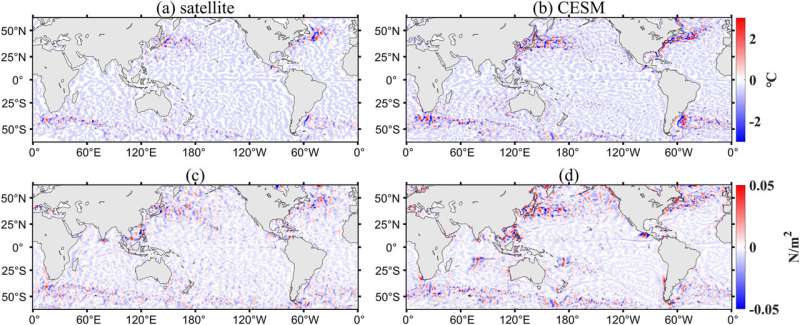Study reveals mesoscale air-sea interactions in the mid-latitudes and underlying mechanisms

A research team led by Prof. Zhang Ronghua from the Institute of Oceanology of the Chinese Academy of Sciences (IOCAS) has investigated the mesoscale air-sea interactions and underlying mechanisms in the mid-latitudes, providing new insights into the mechanisms of atmospheric responses to mesoscale sea-surface temperature perturbations.
The study was published in the Journal of Advances in Modeling Earth Systems.
High-resolution satellite measurements indicate a strong positive correlation between mesoscale sea-surface temperature (SST) and surface wind stress perturbations in the extratropical oceans, but low-resolution coupled ocean-atmosphere models have difficulty in accurately simulating the corresponding spatial patterns and coupled intensity.
The researchers used simulated products from a high-resolution Community Earth System Model (CESM-HR) to assess the extent to which the mesoscale coupling is captured in this study, focusing on two regions respectively, the Kuroshio Extensions (KE) and Agulhas Return Current (ARC).
They found that, compared with satellite observations, the CESM-HR could depict the characteristics of the mesoscale air-sea coupling well, with its strength being comparable to what was observed; but in the KE region, the simulated strength during summer was only half of the observed.
Then, they analyzed mechanisms for the atmospheric responses to mesoscale SST perturbations through the pressure adjustment (PA) and the downward momentum transport (DMT). The results highlighted different mechanisms for controlling the atmospheric responses over the KE and ARC regions, which are regionally and seasonally dependent.
In the ARC region, pronounced dipole patterns of sea surface pressure (SLP) and vertical velocity perturbation responses indicated that the DMT exerted a dominant effect in both winter and summer. In the KE region, monopole patterns showed the main role played by the PA mechanism for the atmospheric adjustment in summer, while dipole patterns indicated the main role played by the DMT mechanism in winter.
Because the PA mechanism is mainly manifested as vertical heat transport which acts to adjust sea surface air pressure, the weak coupling strength indicates that the parameterization of vertical heat mixing in the atmospheric model is not appropriately represented and thus needs to be improved.
This finding is important for improving the parameterizations of the CESM-HR for enhancing high resolution and long-time prediction capability.
More information: Zhijia Tang et al, Mesoscale Surface Wind‐SST Coupling in a High‐Resolution CESM Over the KE and ARC Regions, Journal of Advances in Modeling Earth Systems (2021). DOI: 10.1029/2021MS002822
Provided by Chinese Academy of Sciences
















